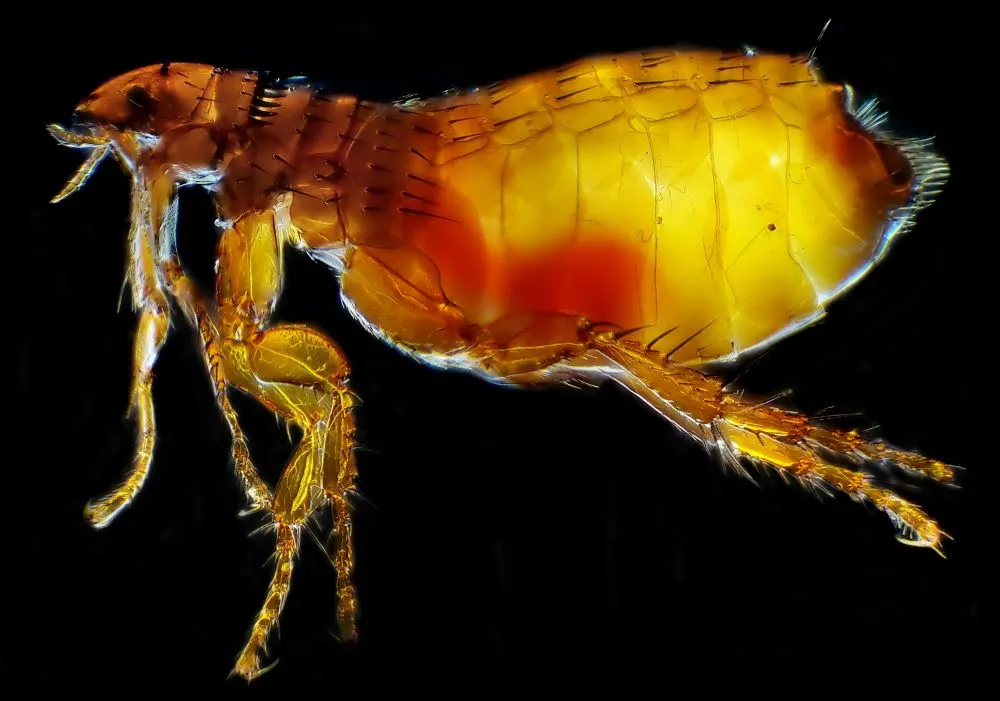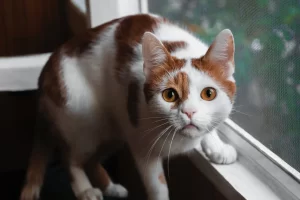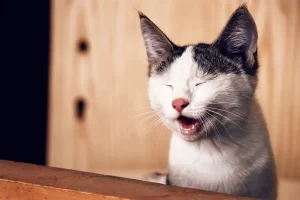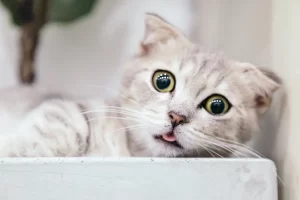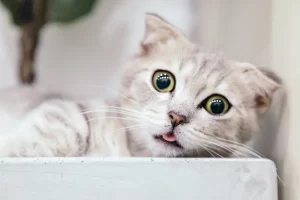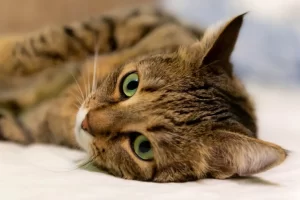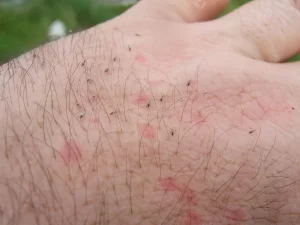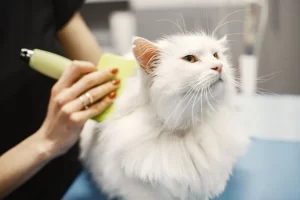Flea infestations can be a frustrating and stressful problem for cat owners. Understanding how to identify cat fleas and their symptoms is crucial in maintaining the health and comfort of your feline friend. Cat fleas, also known as Ctenocephalides felis, are small, wingless insects that feed on the blood of their host, in this case, cats. They can cause itching and irritation, leading to hair loss and even secondary infections such as hot spots, scabs and bacterial skin infections. In this article, we will delve into the characteristics of cat fleas, how to identify them, their life cycle and the signs of infestation on cats. We will also discuss the most effective ways to prevent and treat flea infestations in cats, so you can take action as soon as possible to keep your cat healthy, comfortable and your home flea-free.
Table of Contents
ToggleWhat are cat fleas?
Cat fleas, scientifically known as Ctenocephalides felis, are small, wingless insects that feed on the blood of their host, in this case, cats. They are dark brown in color, around 2-3 mm in length, and have a flattened body shape that enables them to move easily through their host’s fur. They possess large hind legs that allow them to jump long distances, which makes it easy for them to move from one host to another, and they are ectoparasites, which means they live on the outside of the host’s body. Cat fleas can cause a variety of symptoms for your feline friend, including itching and irritation, leading to hair loss, redness and even secondary infections. They can also lead to anemia, especially in young or frail cats as they can consume a lot of blood. Additionally, cat fleas can also infest your home and become a persistent problem that is difficult to eliminate. They can survive in the environment, including carpets, furniture, and pet beds and can lay hundreds of eggs that can hatch in a few days.
What do cat fleas look like to the human eye?
To help you better detect and identify fleas on your cat, here we have gathered some reference images to show you what cat fleas look like to the human eye.
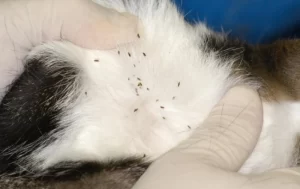
Here is the microscopic view of the young and fully grown cat fleas as well as cat flea eggs.
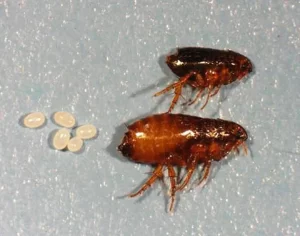
To get a better feeling about the size of the cat flea eggs, here you can see the eggs on a fingertip.
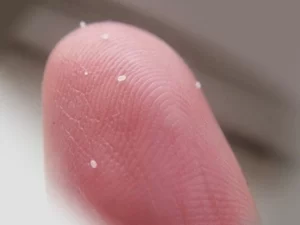
Or here is the zoomed-in view of fleas in cat fur.
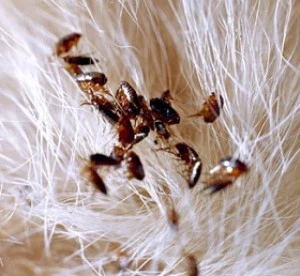
It is important to remember that not all fleas are cat fleas. To better understand the differences between different fleas, you can use this reference image.
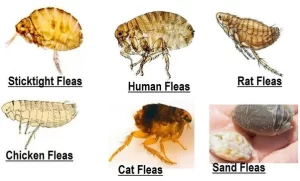
How do you know your cat has cat fleas?
There are several signs that can indicate that your cat has fleas. Here are a few ways to know:
- Itching and scratching: If your cat is frequently scratching or biting at its skin, it may be a sign that it has fleas.
- Bite marks: Fleas can cause small, red bite marks on your cat’s skin. These marks may be accompanied by itching and scratching.
- Hair loss: Fleas can cause hair loss in cats, especially around the base of the ears and tail.
- Dark specks: You may notice small dark specks on your cat’s skin or in its bedding, these are flea feces, which are composed of digested blood.
- Presence of fleas: You can physically see the fleas on your cat’s fur, they are small, dark brown, and move quickly.
- Tapping: When you pet your cat, you can feel the small bumps caused by fleas running on the cat’s skin.
read more on What Fleas Do to Cats and Kittens if interested. Note that not all cats will show signs of flea infestation, some cats may have a flea allergy and will show severe symptoms while other cats may have very few symptoms. Additionally, flea infestations can also be present in your home, so it’s important to be vigilant and check your cat and your home regularly for signs of fleas. If you are still not sure if your cat has fleas or not, follow these simple steps to find out.
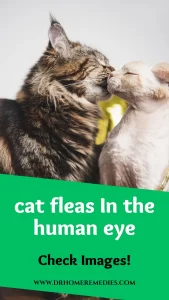
Different varieties of cat fleas
There are several types of fleas that can infest cats, but the most common type is the cat flea, also known as Ctenocephalides felis. This is the most common flea found on cats worldwide. Other types of fleas that can infest cats include:
- Dog flea: Ctenocephalides canis, it can also infest cats, especially if they live in close proximity to dogs.
- Human flea: Pulex irritans, it is a rare flea found on cats and humans, and it is usually found in areas where humans and cats live in close proximity.
- Sand flea: Tunga penetrans, it is found in tropical and subtropical regions, it can infest cats and humans.
- Oriental rat flea: Xenopsylla cheopis, it is a flea that is primarily found on rats, but can also infest cats and humans.
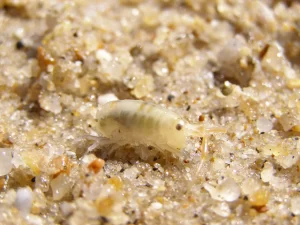
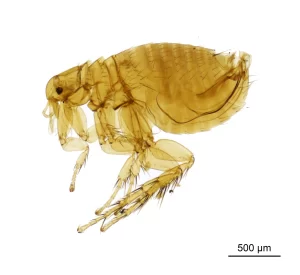
The cat flea, Ctenocephalides felis, is the most common flea found on cats worldwide, it is a small, wingless insect that feeds on the blood of its host. They are dark brown in color and are about 2-3 mm in length. They have a flattened body shape, which allows them to move easily through their host’s fur. They have large hind legs that allow them to jump long distances, which makes it easy for them to move from one host to another.
Other types of fleas, such as the dog flea, human flea, sand flea, and oriental rat flea, can also infest cats. While they may have different characteristics and behaviors, they all have the ability to feed on the blood of cats and cause similar symptoms. For example, the dog flea, Ctenocephalides canis, is similar in appearance to the cat flea, but it is more commonly found on dogs. The human flea, Pulex irritans, is a rare flea found on cats and humans, usually in areas where the two live in close proximity. The Sand flea, Tunga penetrans, is found in tropical and subtropical regions and can infest cats and humans. The oriental rat flea, Xenopsylla cheopis, is primarily found on rats, but can also infest cats and humans. It’s important to understand the characteristics and behaviors of the different types of fleas in order to effectively prevent and treat infestations.
The Blood Source of Cat Fleas: Understanding Where Fleas Feed on Cats
Cat fleas primarily sustain themselves by feeding on the blood of their host, in this case, cats. These tiny parasites employ their sharp mouthparts to pierce the host’s skin and access the blood flowing within the capillaries. Fleas have distinct feeding preferences when it comes to cats, gravitating toward areas that are typically less protected by fur. These favored feeding zones include the cat’s ears, head, neck, and hind legs. However, it’s important to note that depending on the location of their bites and the extent of the infestation, fleas can also feed on other parts of the cat’s body.
Feeding by fleas can provoke various uncomfortable consequences for the host cat, including itching and irritation, which may lead to hair loss and, in severe cases, secondary infections. Moreover, fleas are not confined to their feline host; they can infest the surrounding environment, permeating carpets, furniture, and pet bedding. This environmental infestation can be notoriously challenging to eradicate, necessitating comprehensive and persistent efforts to ensure the home remains flea-free.
The Reproduction process of Cat Fleas
Yes, cat fleas lay eggs. Flea eggs are small, white, and oval-shaped, about 0.5 mm in length. They are usually laid on the host’s fur or in the environment where the host lives, such as carpets, furniture, and pet beds. These eggs can fall off the host and onto the floor, where they can hatch and develop into adult fleas. Fleas lay their eggs at a rate of around 20-30 eggs per day and can lay up to 2000 eggs in their lifetime.
The eggs are not sticky and will fall off the host onto the environment, which is why it’s essential to clean your home and vacuum carpets, furniture and pet beds regularly. The eggs will hatch in about 1-10 days, depending on the temperature and humidity. Once the eggs hatch, the larvae will feed on organic debris and adult flea feces, which contains partially digested blood. After 3-5 days, the larvae will spin a cocoon and become pupae. Pupae can remain dormant for several weeks to several months, depending on the temperature, humidity, and other environmental factors before emerging as adult fleas.
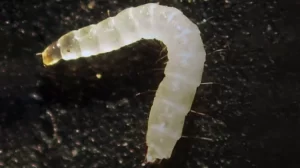
Can cat fleas be seen by the naked human eye?
Yes, cat fleas can be seen by the human eye, although they are quite small, typically measuring about 2-3 mm in length. They are dark brown in color and have a flattened body shape, which allows them to move easily through their host’s fur. They can be seen on the host’s skin, moving quickly, and can be identified by their long hind legs that allow them to jump long distances. However, it’s important to note that cat fleas are small and can be difficult to spot, especially if they are hiding in the host’s fur. Additionally, flea feces and eggs can also be seen, they are small, dark specks and can be found on the host’s skin, bedding or in the environment. Pet owners should be aware of the shapes of these fleas as they can also live on humans and even bite them.
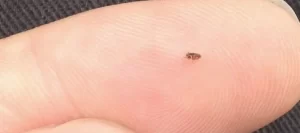
What color are cat fleas?
Cat fleas are typically dark brown in color. When they are not engorged with blood, they tend to be a dark brown color, but when they have fed, they will appear reddish-brown as they have taken in blood. They are small, wingless insects that are about 2-3 mm in length. They have a flattened body shape, which allows them to move easily through their host’s fur. They have large hind legs that allow them to jump long distances, which makes it easy for them to move from one host to another. They are ectoparasites, meaning they live on the outside of the host’s body, and they can cause itching, irritation, and even secondary infections.

How big are cat fleas?
Common Misconceptions: Mistaking Other Parasites for Cat Fleas
Cat fleas are often mistaken for other types of small, dark-colored insects, such as:
- Bed bugs: They are reddish-brown in color and are around the same size as cat fleas, but they do not have hind legs that allow them to jump.
- Lice: They are also small, wingless insects that can infest cats, but they are typically gray or white in color and are more elongated in shape than fleas.
- Ticks: They are larger than fleas, typically around 5 mm in length, and they have a more rounded shape. Ticks are also typically found on the ears, head, and neck and are slow-moving.
- Mites: Mites are tiny, wingless arthropods that can infest cats, but they are typically smaller than fleas and are less mobile.
It’s important to note that fleas can be difficult to spot, especially if they are hiding in the host’s fur. Additionally, flea feces and eggs can also be mistaken for other types of debris. A veterinarian can help to identify the specific type of parasite and recommend the appropriate treatment.
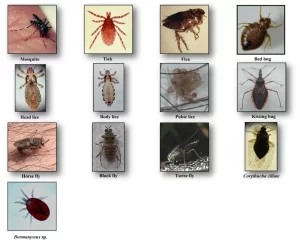
How to check your cat for fleas?
To check your cat for fleas, you can start by running a flea comb through their fur. Flea combs have very fine teeth that can help to remove fleas and their eggs from your cat’s coat. You can also look for small, dark specks on your cat’s skin, which may be flea dirt (digested blood excreted by fleas). Additionally, you can check for signs of itching or biting, as well as redness or irritation on your cat’s skin, which may indicate the presence of fleas. If you suspect your cat has fleas, it’s important to consult with your veterinarian to determine the best course of treatment.
Read More: How often do you take a cat to the vet?
The differences between cat fleas and bed bugs
Cat fleas are small, dark brown, and have a flattened body shape. They are typically around 1/8 inch long and have six legs. They also have a distinctive jumping ability, which can help you spot them.
Bed bugs, on the other hand, are reddish-brown in color and have a more oval-shaped body. They are about the size of an apple seed and have six legs. They are also wingless. Bed bugs are known for their blood-sucking habits and leaving behind reddish-brown fecal spots.
If you suspect an infestation of either, it’s best to consult with a pest control professional for proper identification and treatment.
Home remedies to get rid of cat fleas
For your convenience, we have gathered a complete list of home remedies that can be used to get rid of cat fleas which can be found here.
Videos we suggest our readers watch
Please note that DrHomeRemedies.com doesn’t own these videos and therefore cannot guarantee their accuracy or correctness.

